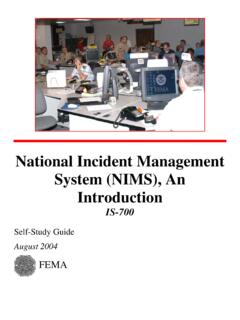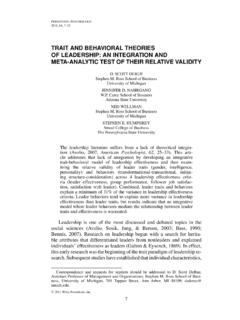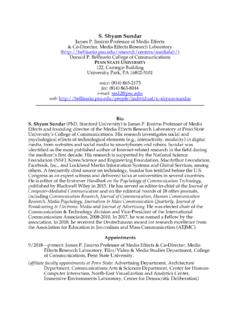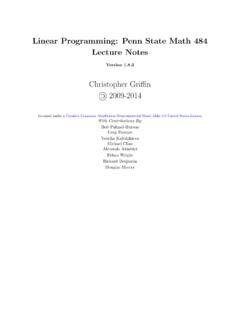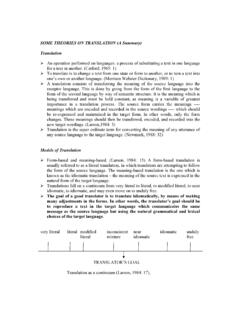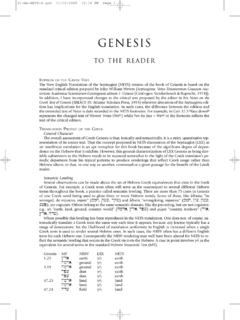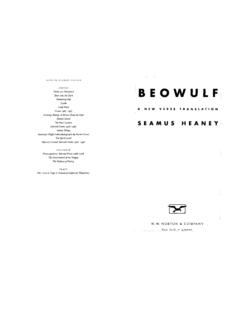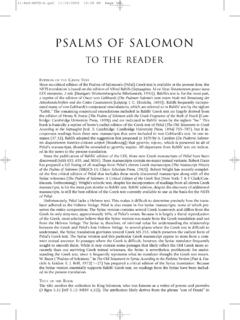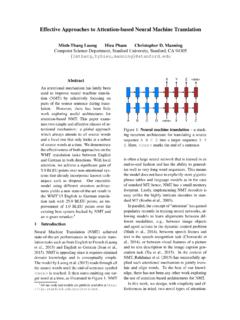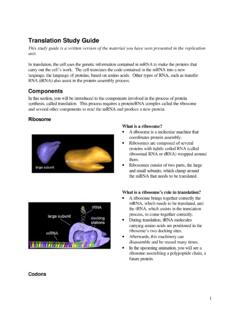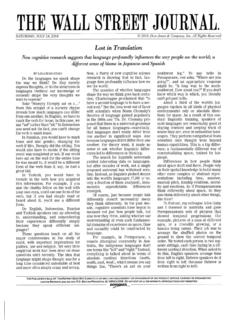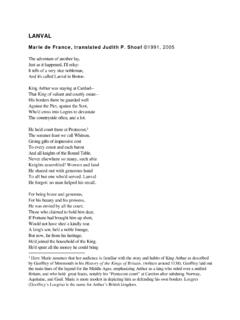Transcription of The Grammar-Translation Method
1 1 - i, Larsen-Freeman, D. (2000). Techniques and principles o/language teaching (2nd ed.). Oxford, UK: Oxford University Press. use the target language, but the mental exercise of learning it would be The Grammar-Translation Method INTRODUCTION The Grammar-Translation Method is not new. It has had different names, but it has been used by language teachers for many years. At one time it was called the Classical Method since it was first used in the teaching of the classical languages, Latin and Greek (Chastain 1988). Earlier in this century, this Method was used for the purpose of helping students read and appreciate foreign language literature. It was also hoped that, through the study of the grammar of the target language, students more familiar with the grammar of their native language and that this familiarity would help them speak and write their native language better.
2 Finally, it was thought that foreign language learning would help students it was recognized that students would probably never beneficial anyway. Let us try to understand t1H~ Grammar-Translation Method by observ-ing a class where the teacher is using it. The class is a high-intermediate level English class at a university in Colombia. There are forty-two stu-dents in the class. Two-hour classes are conducted three times a week. EXPERIENCE As we enter the classroom, the class is in the middle of reading a passage in their textbook. The passage is an excerpt entitled 'The Boys' Ambition' from Mark Twain's Life on the Mississippi. Each student is called on to read a few lines from the passage. After they have finished reading, they are asked to translate into Spanish the few lines they have just read.
3 The teacher helps them with new vocabulary items. When the students finished reading and translating the passage, the teacher asks them in Spanish if they have any questions. One girl raises her hand and says, 'What is paddle wheel?' The teacher replies, 'Es una rueda de paletas.' Then she continues in Spanish to explain how it looked and worked on steamboats which moved up and down the Mississippi River during ------------'"; S",,'II 7 12 The Grammar-Translation Method Mark Twain's childhood. Another student says, 'No understand "gor-geous.'" The teacher translates, 'Primoroso.' Since the students have no more questions, the teacher asks them to write the answers to the comprehension questions which appear at the end of the excerpt. The questions are in English, and the students are instructed to write the answers to them in English as well.
4 They do the first one together as an example. A student reads out loud, 'When did Mark Twain live?' Another student replies, 'Mark Twain lived from 1835 to 1910.' 'Bueno; says the teacher, and the students begin working qui-etly by themselves. In addition to questions that ask for information contained within the reading passage, the students answer two other types of questions. For the first type, they have to make inferences based on their understanding of the passage. For example, onc question is: 'Do you think the boy was ambitious? Why or why not?' The other type of question requires the stu-dents to rclate the passage to their own experience. For example, onc of the questions based on this excerpt asks them, 'Have you ever thought about running away from home?
5 ' After one-half hour, the teacher, speaking in Spanish, asks the students to stop and check their work. One by one each student reads a question and then reads his or her response. If it is correct, the teacher calls on another student to read the next question. If the answer is incorrect, the teacher selects a different student to supply the correct answer, or the teacher herself gives the right answer. Announcing the next activity, the teacher asks the students to turn the page in their text. There is a list of words there. The introduction to the exercise tells the students that these are words taken from the passage they have just read. The students see the words 'ambition,' 'career,' 'wharf,' 'tranquil,' 'gorgeous,' 'loathe,' 'envy,' and 'humbly.
6 ' They are told that some of these are review words and that others are new to them. The students are instructed to give the Spanish word for each of them. This exercise the class does together. If no one knows the Spanish equiva-lent, the teacher gives it. In Part 2 of this exercise, the students are given English words like 'love,' 'noisy,' 'ugly,' and 'proudly,' and are directed to find the opposites of these words in the passage. When they ha ve finished this exercise, the teacher reminds them that English words that look like Spanish words are called 'cognates.' The English '-ty,' she says for example, often corresponds to the Spanish end-ings -dad and -tad. She calls the students' attention to the word 'possibil-ity' in the passage and tells them that this word is the same as the Spanish posibilidad.
7 The teacher asks the students to find other examples in The Grammar-Translation Method 13. Exercise 2A These words are taken from the passage you have just read. Some of them are review words and others are new. Give the Spanish translation for each of them. You may refer back to the reading passage. ambition gorgeous career loathe wharf envy tranquil humbly Exercise 2B These words all have antonyms in the reading passage. Find the antonym for each: love ugly noisy proudly excerpt. Hands go up; a boy answers, 'Obscurity.' 'Bien,' says the teacher. When all of these cognates from the passage have been identified, the stu-dents are told to turn to the next exercise in the chapter and to answer the question, 'What do these cognates mean?
8 ' There is a long list of English words ('curiosity,' 'opportunity,' 'liberty,' etc.), which the students trans-late into Spanish. The next section of the chapter deals with grammar. The students fol-low in their books as the teacher reads a description of two-word or phrasal verbs. This is a review for them as they have encountered phrasal verbs before. Nevertheless, there are some new two-word verbs in the passage the students haven't learned yet. These arc listed following the description, and the students are asked to translate them into Spanish. Then they are given the rule for use of a direct object with two-word verbs: Ifthe two-word verb is separable, the direct object may come between the verb and its particle. However, separation is necessary when the direct object is a pronoun.
9 If the verb is inseparable, then there is no separation of the verb and particle by the object. For example: John put away his book. or John put his book away/John put it away. 14 The Grammar-Translation Method but not John put away it. (because 'put away' is a separablNwo-word verb) The teacher went over the homework. but not The teacher went the homework over. (because 'go over' is an inseparable two-word verb). After reading over the rule and the examples, the students are asked to tell which of the following two-word verbs, taken from the passage, are sep-arable and which inseparable. They refer to the passage for clues. If they cannot tell from the passage, they use their dictionaries or ask their teacher. turn up wake up get on take in run away fade out lay up go away breakdown turn back Finally, they are asked to put one of these phrasal verbs in the blank of each of the ten sentences they are given.
10 They do the first two together. , " 1 Mark Twain decided to __ because his parents wouldn't let him get a job on the river. 2 The steamboatmen __ and discharge freight at each port on the Mississippi River. When the students are finished with this exercise, they read their answers aloud. At the end of the chapter there is,a list of vocabulary items that appeared in the passage. The list is divided into two parts: the first con-tains words, and the second, idioms like 'to give someone the cold shoul-der.' Next to each is a Spanish word or phrase. For homework, the teacher asks the students to memorize the Spanish translation for the first twenty words and to write a sentence in English using each word. In the two remaining lessons this week, the students will be asked to: 1 Write out the translation of the reading passage into Spanish.
